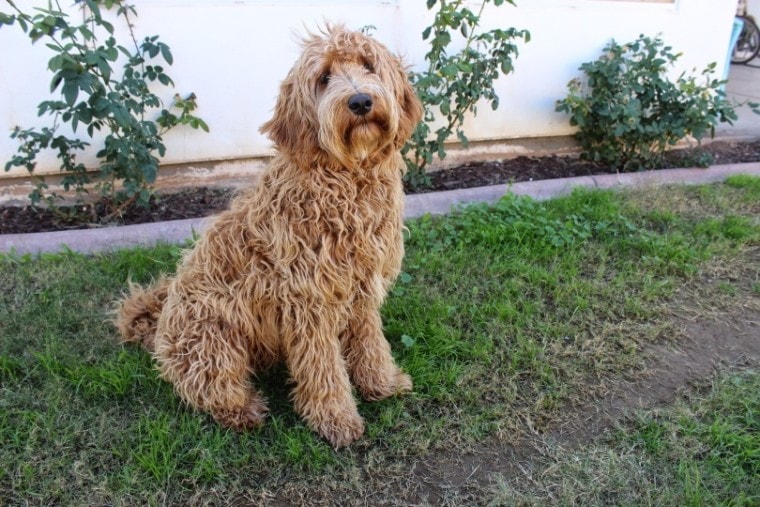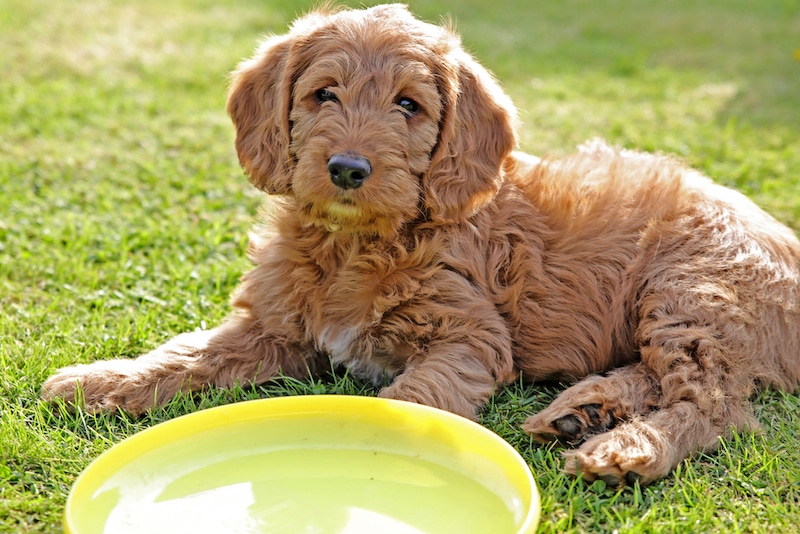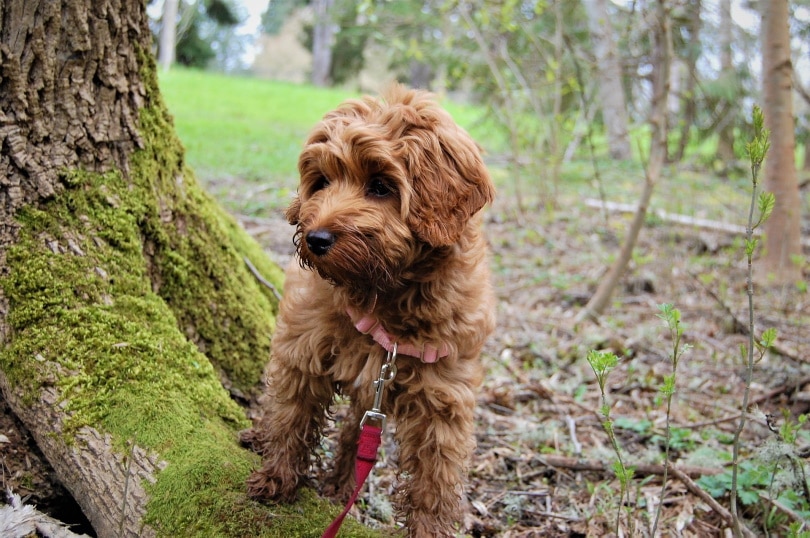
Click Below to Skip Ahead
The Poodle and the Labrador Retriever were bred together with the hope of creating a hypoallergenic service dog for people with allergies to pet dander. Today, the Labradoodle is becoming increasingly popular with people who are looking for a low-maintenance family pet. Labradoodles make fun and affectionate companions and are worthy candidates for therapy dogs.
Breed Overview
Height:
21–24 inches
Weight:
50–65 pounds
Lifespan:
12–16 years
Colors:
Black, cream, white, apricot, gold, caramel, chocolate, red, tan, sable
Suitable for:
Active families, families with children, those looking for a playful and active dog
Temperament:
Affectionate, intelligent, friendly, energetic, playful, easy-going
While Labradoodles are known for being sweet, their consistency in other characteristics is lacking. The demand for these dogs contributes to irresponsible and hasty breeding, and the results are litters of puppies with varying personalities. Not all Labradoodles are exactly alike but they do share similar characteristics.
Labradoodle Characteristics
Labradoodle Puppies

Labradoodle puppies are highly intelligent and social, and tend to be good with children and other pets. They are also known for being easily trained and make great family pets. Labradoodles come in a variety of sizes, coat types, and colors, which can range from straight to curly and from black to cream.
Labradoodles, like all hybrid breeds, can exhibit a range of physical and behavioral traits from both parent breeds, so it is important to research the background of the individual dog to get a sense of what to expect.

Temperament & Intelligence of the Labradoodle
Labradors and Poodles are both smart dogs, so the Labradoodle inherits intelligence from both parent breeds. These are smart and loveable dogs that enjoy following commands and completing tasks. This is another reason that Labradoodles are used as service and therapy dogs. Their gentle dispositions combined with their intelligence and love for people make them ideal for anyone, from first-time dog owners to those with a house full of pets. They are low-maintenance dogs that are happy to spend time with their families.
They can suffer from separation anxiety if they are left alone for too long. This can manifest through barking, howling, pacing, urinating in the house, and being destructive. If you’re going to be gone for a long period, consider having someone like a dog-walker or friend stop by to visit your dog and take them for a walk. A break in the middle of the time that you’re gone will help keep your Labradoodle entertained and happy.
Are These Dogs Good for Families? 👪
Labradoodles make loving additions to families. They get along well with kids, but their large size and playful natures could overwhelm small children. If this breed is properly trained and socialized, they make loyal companions that are devoted to their families.
Does This Breed Get Along With Other Pets?
Labradoodles love people and other animals alike and get along well with other pets in the home. Their gentle and accepting personalities make them ideal for a home with other animals. The best way to ensure that your Labradoodle will be friends with the other animals in the household is to raise the animals together. Puppies will grow to love and accept other housemates as family.
Adding a Labradoodle puppy to a house with other pets is easier than adding an adult Labradoodle to the mix. That said, while it may take longer for the adult dog to become familiar with everyone, they will be happy to do so. Training and socialization when the Labradoodle is a puppy, though, are crucial to their success living with other animals.

Things to Know When Owning a Labradoodle
Labradoodles are social dogs that are happiest when around their people. Whether you’re a single dog owner or you adopted this dog to add to your big family, you’ve gained a loyal friend. However, there are several requirements to be aware of when welcoming this dog into your home. Here are a few things to consider about owning Labradoodles.
Food & Diet Requirements 🦴
Puppies need to eat more frequent meals than adults. When you bring your puppy home, they should be kept on the same diet that they were eating previously. This will help you avoid any digestive distress from a sudden change in food. Gradually, you can switch them to the food that you’d prefer that they eat. A high-quality, protein-packed kibble will work well for puppies and adult Labradoodles. Just make sure you’re feeding your dog the recommended amounts for their age and activity level.
If you’re unsure which food is best for your Labradoodle, your veterinarian can help you create a diet that is the healthiest for your dog. There is no one universal dog food that will offer the same nutrients to every dog. Just like people, different dogs need specialized diets suited to their needs.
Treats are always welcome by Labradoodles and are motivators during training. Avoid any accidental weight gain by offering low-calorie treats, especially if you’ll be using many of them in a training session. A handful of dry kibble offered piece by piece will also work, depending on how food-motivated your dog is and how much they enjoy their food.
Exercise 🐕
Labradoodles love to play! They can go from sleeping on the sofa to up and waiting at the door to go outside in seconds. They require exercise to be healthy and happy but also to avoid them becoming bored. A bored Labradoodle will make up their own activities, and these may not always be the things that you want them to be doing. If they have sufficient time to burn off their energy, they’ll be much more content. A 30-minute play session per day in a fenced-in area where the dog can run or chase a ball will provide the mental and physical stimulation that they need. If this isn’t possible, a 30–to 60-minute walk each day will allow them to get exercise while sniffing and exploring the world around them. However you choose to do it, your Labradoodle will enjoy the exercise and the time with you.

Training 🎾
Labradoodles are smart, energetic, and easy to train. They like learning new things and following commands. Their trainability makes them reliable and competent service dogs. If you welcome this dog to your home as a pet, there are a few things that you can do to help them be the best they can be. Socializing your new puppy is the most important step to take from the time that you bring them home. This encourages your dog to not fear new experiences, people, or places and instead, to be intrigued by new things. A puppy socialization class is a good place to start. Playdates with your friends and their dogs will help your dog learn to make friends.
Obedience classes will teach your dog basic manners and how to follow simple instructions. From there, you can move on to agility classes, to help your dog get the exercise that they need while focusing on an activity.
Labradoodles learn quickly through the proper methods, so you shouldn’t have any trouble teaching your dog whatever you’d like. Patience and repetition are required from you so your dog associates learning with a positive experience.
Grooming ✂️
Depending on your preference, your Labradoodle can be groomed whenever you like. If you get this done professionally, it will include a haircut, nail trim, and bath. You can bathe your dog yourself at home, but if you want their coat trimmed and you don’t know how to do that, opt for a professional groomer to keep their coats tidy. Regular nail trims are important for paw health. Overgrown nails can be painful and make walking difficult for your dog. Their curly coats can become long and unruly, so depending on how short you’d like their coats, get them groomed regularly. This hair can grow over their eyes, impairing the dog’s vision.
Brushing your dog’s teeth will help prevent dental issues like gingivitis and periodontal disease. Getting your dog into the habit of having their teeth brushed when they’re young will help them tolerate the activity more as adults.
- Related Read: Chocolate Labradoodle: Facts, History & Origin

Health and Conditions 🏥
Labradoodles are generally healthy dogs, but they’re genetically predisposed to certain diseases that affect their parent breeds, the Labrador and the Poodle. In addition, the popularity of Labradoodles has increased, leading to overbreeding and irresponsible breeding. Breeding this way doesn’t aim to eradicate health issues in the puppies, but rather to make a profit. If you have a Labradoodle, these are potential issues that could arise down the road. Regular veterinary exams are important for the prevention and detection of these conditions.
Serious Conditions:
- Hip and elbow dysplasia: During the growth of the hip or elbow ball and socket joints, both the ball and socket must grow together. If they don’t evolve equally, they will eventually become misaligned, leading to extreme pain, walking difficulties, and even lameness in the dog.
- Addison’s disease: This is a disease that occurs when the adrenal glands stop producing hormones correctly.
- Von Willebrand’s disease: This is an inherited bleeding disorder.
Minor Conditions:
- Allergies: These are skin, ear, and digestive issues that can cause severe itching and discomfort.
- Ear infections: These infections can be chronic, especially if your Labradoodle has inherited the waxy ear canal of the Poodle.
Male vs Female
Like people, dogs have their own personalities. There is no scientific evidence proving a male dog is better than a female dog. Which one you invite into your home is your personal preference. People who have owned Labradoodles have said that they noticed things like males being more affectionate and loving than females, which are independent and stubborn. Others say that females are more mature and intelligent than males. There is no one way that males and females behave. Both sexes can be loving, intelligent, and affectionate. It’s a matter of which puppy or adult Labradoodle you happen to fall in love with because both males and females make wonderful pets.
3 Little-Known Facts About the Labradoodle
1. They love water.
Poodles and Labradors are known to like swimming, and the hybrid breed they create is no different. Any water that you have is fine for your Labradoodle. They love any chance to get themselves soaked. If a Labradoodle has access to a pond, lake, a backyard sprinkler, or even the rain, they can entertain themselves endlessly.
2. They’re friendly.
Labradoodles don’t make good guard dogs because they’re too busy making friends. This dog knows no stranger and will be welcoming to everyone they meet. A Labradoodle isn’t the best choice for home security. They want to be social and friendly and don’t display aggression or dominance.
3. Their coats differ.
Not all Labradoodles look the same! Their coats can be of different colors and textures. Some coats can feel like fleece, while others feel like wool. Some coats are rough and curly and others are smooth and wavy.
Summary
If you want to add a dog to your home that is sweet, silly, playful, and smart, look no further than the Labradoodle. Whether you purchase a puppy from a breeder or adopt an older dog from a rescue, you are getting a loving companion. Welcoming this dog into your life means you’ll have to do a bit of socializing and training, but you’ll be rewarded for years to come with a loyal and special friend.
Read more:
- How Much Do Australian Labradoodles Cost? Facts & FAQ
- 10 Best Harnesses for Labradoodles: Reviews & Top Picks
Featured Image Credit: Josh Borup, Pixabay







